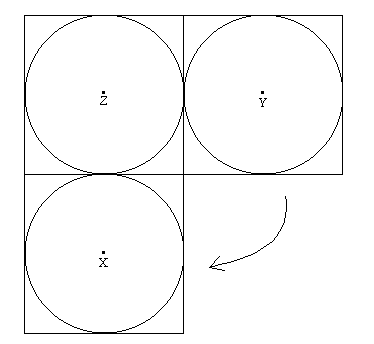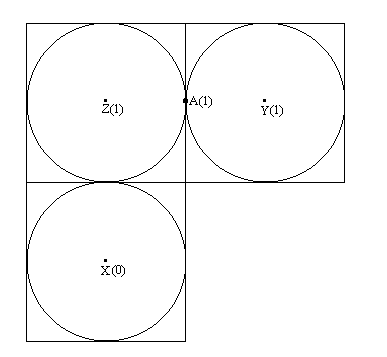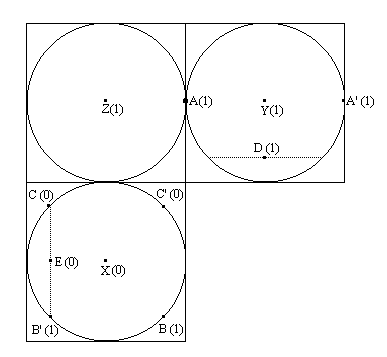The Kochen-Specker paradox
According to quantum mechanics, if the spin of a particle is measured in a particular
direction, its value may be 1, 0, or -1. If we just consider squared spins, there will be
only two values, 0 and 1. Now again according to quantum mechanics, if the squared spins
are measured in three mutually perpendicular directions, the results must be 1, 1 and 0
in some order. The Kochen-Specker paradox states that it is then impossible for the
squared spins of a particle from every possible direction to be predetermined.
The proof of it involves reductio ad
absurdum. We assume it is possible to have predetermined spins, and then show that this
would inevitably lead to a measurement which would have to be both 0 and 1 to be consistent
with the other measurements. The argument is straightforward but lengthy, as a good many
different
measurements have to be made before we reach the inconsistent ones!
The proof that follows is my own version. A formal one is given in John Conway and Simon
Kochen's paper The Free Will Theorem.
It is simplest to regard a particle as a sphere, and
even easier for our purposes to imagine it enclosed in a cube each face of which just
touches the sphere. Directions for measurement can then be imagined as needles passing
through the cube and sphere and out the other side. We only need to bother with three
sides of the cube rather than all six, and I for one find two dimensions easier to
visualise than three. The three sides of the cube can be flattened into a plane, as shown
in the figure below to the left:

|
The arrow shows which sides of the half cube would come together on folding up into three
dimensions. Imagine the fold between the X and the Z faces as coming out of the page on
folding.
If we call the centre of the sphere Σ, then clearly the lines, or directions,
XΣ, YΣ and ZΣ all meet at right angles to each other at Σ:
they are orthogonal. According to quantum theory, the squared spins measured in those
directions must be 1, 0 and 1 in some order. Without loss of generality, we could suppose
that the squared spin in the XΣ direction was 0, and that in the other two
directions 1. Since Σ comes into every direction, we might as well abbreviate what
we have supposed by writing X=0, Y=1, Z=1. |
In what follows we shall be looking for more triads of orthogonal directions. It is
useful to think about what that means three dimensionally.
The diagram shows how any of the three points on the sphere can be considered as a
pole, while the other two lie on an equator. If we take X above as a
pole, then Y and Z are on its equator. |

|

|
In the next diagram to the left, the squared spins are shown as numbers in brackets. A
new point A has appeared. Unlike Y and Z, A is not on the equator of the sphere with
respect to X, but on the surrounding cube. Nevertheless A is in the same plane as that
equator, so AΣ is orthogonal to
XΣ, meaning that
the squared spin in its
direction is 1. A=1, just as Y=1 and Z=1.
|
|
In the diagram to the right, J and K represent two points on the cube, in the same plane
as Z's equator. The advantage of having the cube as well as the sphere can now be made
apparent, in the diagram to the left below:
|

|

|
If we imagine a slice through the cube including J and K and with Σ at its centre,
then clearly JΣ and KΣ are orthogonal, as shown.
|
Now suppose the plane containing J and K is
rotated about X, as indicated by an arrow in the right hand diagram.
Eventually it will reach a position where it is orthogonal to AΣ. Suppose that at
that point, J and K have rotated into the positions shown by C and B. Then AΣ,
BΣ and CΣ are all orthogonal. Since A=1, we must either have B=1 and C=0, or
B=0 and C=1. Neither BΣ nor CΣ is orthogonal to any other direction so
far, so the choice is ours. Let's put B=1 and C=0. Finally here notice that the rotation that takes J to C must be through
45o,
since rotating from Z to A takes us half way across the cube.

|
In the next diagram to the left, the vertical dotted line indicates the plane of Y's
equator. A new point A' is shown, and A'=1, since it is in the plane of X's equator. We
can imagine rotating Y's equatorial plane until it becomes orthogonal to A'Σ, and
contains C' and B' as shown. Either B'=0 or C'=0, but there are no other orthogonals to
determine which. We choose B'=1 and C'=0, then, without loss of generality.
|
|
A slightly more complicated bit of imagination needed to the right. The plane through Z
and X, indicated by the vertical dotted line, is of course Y's equator, and orthogonal to
Y. Suppose we do a bit of rotation about Z, as shown by the arrows. The plane swings round
until it contacts C and B'. Meanwhile Y has moved to the position indicated by D. This
means that DΣ is orthogonal to the plane through Z, C and B', and in particular to
the
direction CΣ. Since C=0, that means that D=1. (Notice that CΣ and B'Σ
are not orthogonal.) |

|

|
Look at the diagram to the left. A new point E has been added. It is on Z's equator, and
also in the plane orthogonal to DΣ. So EΣ, ZΣ and DΣ are all
orthogonal, meaning that E=0.
|
|
Now over to the right, two new points F and G have appeared. Imagining the same rotation
as before from a different viewpoint, we can see that EΣ must be perpendicular to
the plane containing Z, G, D and F. Since E=0, it must be the case that F=1 and G=1.
|

|

|
Not quite so fearsome as it looks to the left. We just go through with a rotation in the
opposite direction, and now get the new points D'=1, E'=0, F'=1 and G'=1.
|
|
On the right we imagine a rotation about Y, taking Z's equatorial plane to the plane
containing F, F' and Y. If you compare this rotation to the previous one which took J to
C, you will see by symmetry that it must also be a 45o rotation. That means it
would take Z to the new point U. By a familiar argument, UΣ must be perpendicular to
the plane containing F, F' and Y, so, since F=1 and F'=1, U=0.
|

|

|
Finally we have a precisely similar argument to show that the new point V=0 in the diagram
to the left. But U and V are at opposite edges of the cube face, so UΣ and VΣ
must be orthogonal. They cannot both have squared spin value 0! We have reached the
reductio ad absurdum at last. Squared spin values cannot be predetermined.
|











